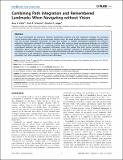Combining Path Integration and Remembered Landmarks When Navigating without Vision
Author(s)
Schrater, Paul R.; Legge, Gordon E.; Kalia, Amy Ashwin
DownloadKalia-2013-Combining Path Integ.pdf (565.1Kb)
PUBLISHER_CC
Publisher with Creative Commons License
Creative Commons Attribution
Terms of use
Metadata
Show full item recordAbstract
This study investigated the interaction between remembered landmark and path integration strategies for estimating current location when walking in an environment without vision. We asked whether observers navigating without vision only rely on path integration information to judge their location, or whether remembered landmarks also influence judgments. Participants estimated their location in a hallway after viewing a target (remembered landmark cue) and then walking blindfolded to the same or a conflicting location (path integration cue). We found that participants averaged remembered landmark and path integration information when they judged that both sources provided congruent information about location, which resulted in more precise estimates compared to estimates made with only path integration. In conclusion, humans integrate remembered landmarks and path integration in a gated fashion, dependent on the congruency of the information. Humans can flexibly combine information about remembered landmarks with path integration cues while navigating without visual information.
Date issued
2013-09Department
Massachusetts Institute of Technology. Department of Brain and Cognitive SciencesJournal
PLoS ONE
Publisher
Public Library of Science
Citation
Kalia, Amy A., Paul R. Schrater, and Gordon E. Legge. “Combining Path Integration and Remembered Landmarks When Navigating without Vision.” Edited by Marc O. Ernst. PLoS ONE 8, no. 9 (September 5, 2013): e72170.
Version: Final published version
ISSN
1932-6203